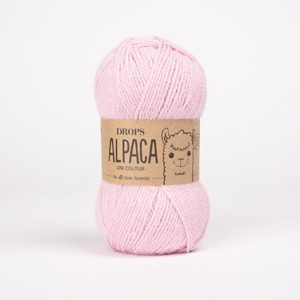Comments / Questions (8)
![]() Roberta wrote:
Roberta wrote:
Buongiorno, un consiglio per favore. Sarebbe un buon abbinamento un capo di Alpaca e uno di Baby Merino? Grazie
30.01.2025 - 15:21DROPS Design answered:
Buonasera Roberta, può guardare nella pagina delle combinazioni per trovare dei suggerimenti sugli abbinamenti di filati. Buon lavoro!
13.02.2025 - 23:09
![]() Doris wrote:
Doris wrote:
Ska resåren verkligen vara 12 cm? Räcker verkligen garnet på 50 gram?
25.11.2024 - 19:51DROPS Design answered:
Hej Doris, ja men du skal bruge 2 x 50 gr :)
27.11.2024 - 07:48
![]() Amanda wrote:
Amanda wrote:
I second the question from Charlotte. Should the tension swatch be used as a reference for the smaller needle or the larger one? Let's say if I manage to make 19 stitches in width on my sample with a size 4.5 needle, should I do the ribbing with the size 4.5 needle and then the rest of the hat with a size 5.5? Thank you
05.10.2024 - 16:00DROPS Design answered:
Dear Amanda, the gauge is with the larger needle, since it's the needle you will use when working in stocking stitch. The smaller needle is only used for the rib edge at the beginning. If you have the gauge indicated with 4.5 needles you will need a smaller needle for the thread, 1 or 2 numbers smaller. Happy knitting!
06.10.2024 - 13:53
![]() Sanne wrote:
Sanne wrote:
Er der andre garntyper kan man bruge til denne opskrift?
18.05.2024 - 15:50DROPS Design answered:
Hei Sanne. Du kan bruke 2 tråder fra garngruppe A (Alpaca, Baby Merino, Fabel, Flora, Kid-Silk, Nord eller Safran) eller 1 tråd fra garngruppe C (Air, Alaska, Alpaca Bouclé, Big Merino, Bomull-Lin, Brushed Alpaca Silk, Nepal eller Paris). Men husk strikkefastheten. mvh DROPS Design
21.05.2024 - 14:20
![]() Birgit Kort wrote:
Birgit Kort wrote:
Hvilke andre garntyper kan man bruge til denne opskrift?
17.05.2024 - 14:05DROPS Design answered:
Hei Birgit. Du kan bruke 2 tråder fra garngruppe A (Alpaca, Baby Merino, Fabel, Flora, Kid-Silk, Nord eller Safran) eller 1 tråd fra garngruppe C (Air, Alaska, Alpaca Bouclé, Big Merino, Bomull-Lin, Brushed Alpaca Silk, Nepal eller Paris). Men husk strikkefastheten. mvh DROPS Design
21.05.2024 - 13:48
![]() Charlotte wrote:
Charlotte wrote:
Bonjour, Comme il faut deux tailles d\'aiguilles pour réaliser ce bonnet, est-ce que l\'échantillon que vous donnez est pour la première partie de l'ouvrage ou la deuxième partie ? c'est-a-dire, si j'arrive à faire 19 mailles en largeur sur mon échantillon avec une aiguille taille 4, est-ce que je dois faire les côtes avec l'aiguille taille 4 puis le reste du bonnet avec une taille 5 ? Merci
17.01.2024 - 12:29
![]() Elaine wrote:
Elaine wrote:
Comment dois-je prendre la mesure pour connaître la grandeur du bonnet?
13.12.2023 - 14:42DROPS Design answered:
Bonjour Elaine, le tour de tête est en général mesuré au niveau du front (comme le bonnet est porté au niveau des côtes ici sur la photo). Bon tricot!
13.12.2023 - 16:23
![]() Vanessa Castleberry wrote:
Vanessa Castleberry wrote:
Cozy hat
04.08.2023 - 16:03
Haze Over Hat#hazeoverhat |
|
 |
 |
Knitted hat in 2 strands DROPS Alpaca. The piece is worked in the round, bottom up with an edge in rib.
DROPS 242-40 |
|
|
------------------------------------------------------- EXPLANATIONS FOR THE PATTERN: ------------------------------------------------------- DECREASE TIP (at top): Knit 2 together after each marker-thread. ------------------------------------------------------- START THE PIECE HERE: ------------------------------------------------------- HAT – SHORT OVERVIEW OF THE PIECE: The piece is worked in the round, bottom up. Begin with circular needles and change to double pointed needles as you decrease. HAT: Cast on 100-108-112 stitches with short circular needle size 3 mm and 1 strand of each colour DROPS Alpaca (= 2 strands). Knit 1 round. Then work rib (knit 2, purl 2) for 12 cm. Turn so you now continue in the round in the opposite direction (gives a neat turn-up). Knit 1 round and decrease 8-12-12 stitches evenly spaced = 92-96-100 stitches. Change to short circular needle size 4 mm. Work stocking stitch in the round. REMEMBER THE KNITTING TENSION! When the hat measures 21-22-23 cm, insert 8 marker-threads: Insert 1 marker-thread at the beginning of the round, then the other 7 as follows: S/M: Insert each marker-thread with alternately 11 and 12 stitches between each one. M/L: Insert each marker-thread with 12 stitches between each one. L/XL: Insert each marker-thread with alternately 12 and 13 stitches between each one. On the next round decrease 1 stitch after each marker-thread - read DECREASE TIP (= 8 stitches decreased). Decrease like this every 2nd round 7 more times = 28-32-36 stitches. Knit 2 rounds where all stitches are knitted together 2 and 2 = 7-8-9 stitches. Cut the strand and pull it through the remaining stitches, tighten and fasten well. The hat measures approx. 28-29-30 cm. Fold the bottom 6 cm up to the right side. |
|
Have you finished this pattern?Tag your pictures with #dropspattern #hazeoverhat or submit them to the #dropsfan gallery. Do you need help with this pattern?You'll find 14 tutorial videos, a Comments/Questions area and more by visiting the pattern on garnstudio.com. © 1982-2025 DROPS Design A/S. We reserve all rights. This document, including all its sub-sections, has copyrights. Read more about what you can do with our patterns at the bottom of each pattern on our site. |
|






















































Post a comment to pattern DROPS 242-40
We would love to hear what you have to say about this pattern!
If you want to leave a question, please make sure you select the correct category in the form below, to speed up the answering process. Required fields are marked *.